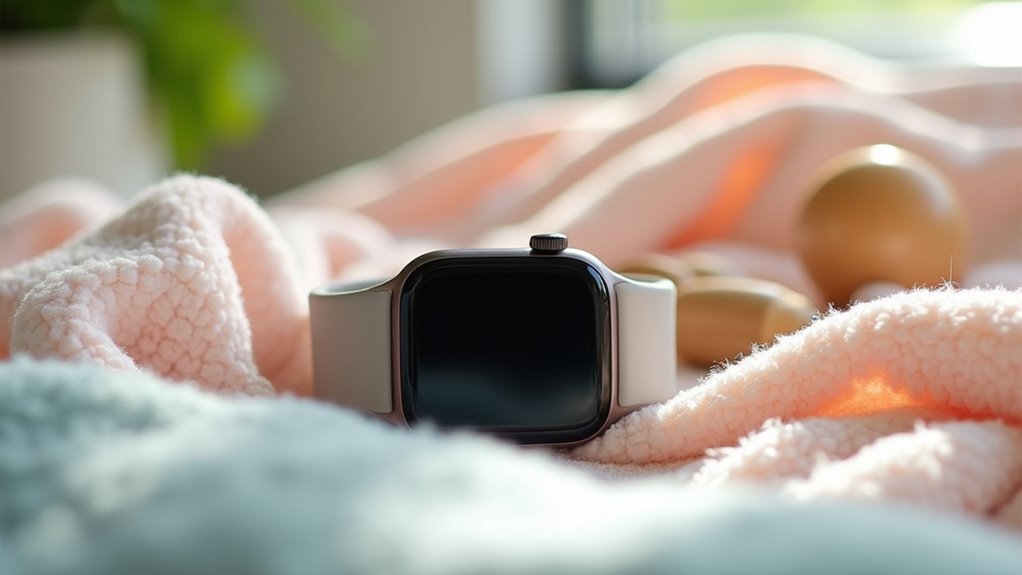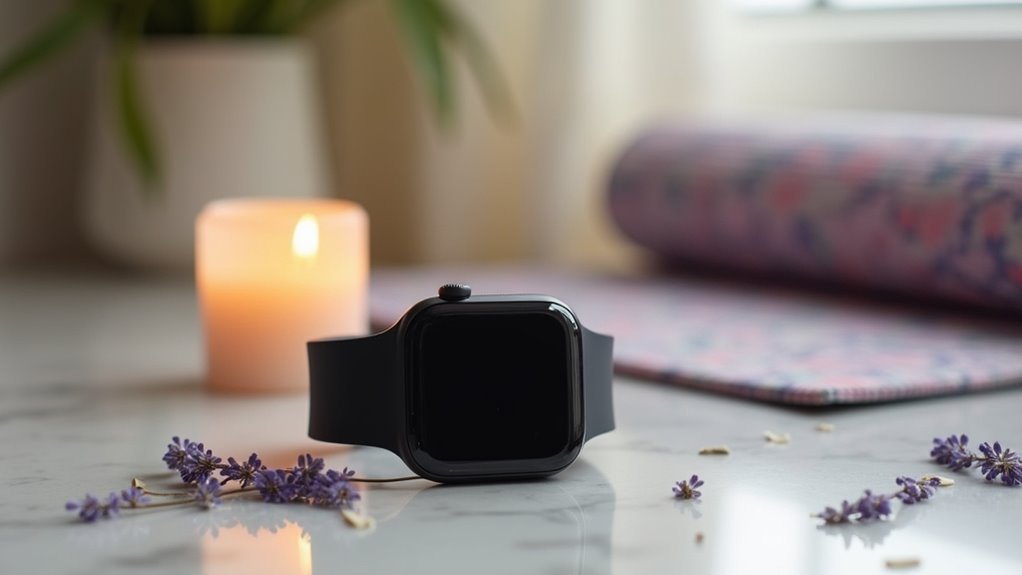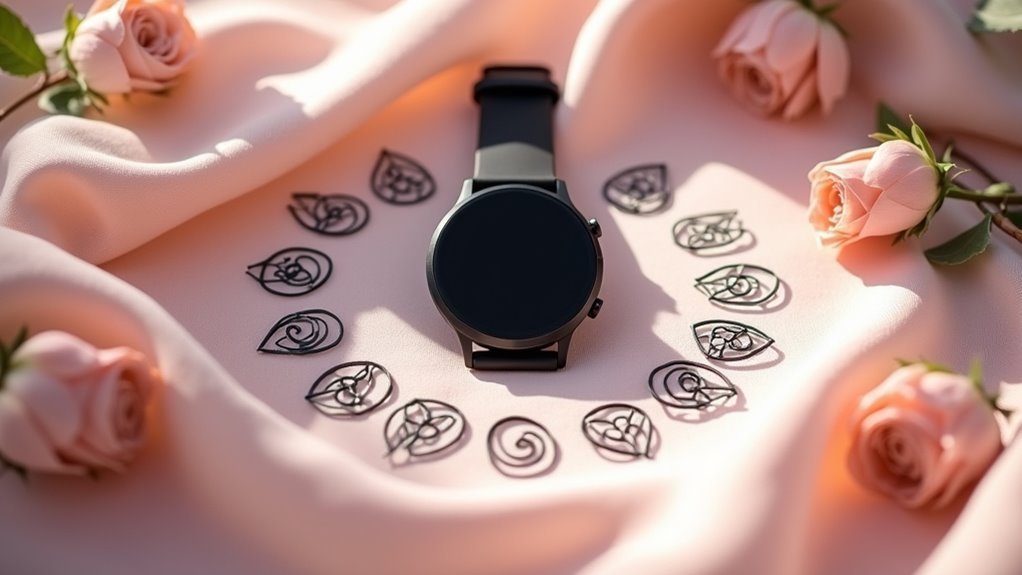You’ll want to prioritize core temperature measurement over basic skin sensors for medical-grade accuracy, then consider form factor preferences between smartwatches, lightweight wristbands, or discreet smart rings. Evaluate battery life ranging from 2-14 days, guarantee compatibility with your smartphone’s operating system, and review privacy policies since these devices collect sensitive biometric data. Look for multi-sensor arrays that combine temperature with heart rate and stress monitoring for thorough health insights. Understanding these key factors will help you make the most informed decision.
Understanding Temperature Sensor Technology in Fitness Wearables
The world of temperature-sensing fitness wearables revolves around two distinct measurement approaches that determine how accurately you’ll monitor your body’s thermal status.
You’ll encounter devices that measure skin temperature directly through sensors on your wrist, providing ambient readings that reflect surface conditions.
Alternatively, advanced wearables estimate core temperature using heat flux measurement and AI algorithms to infer your body’s internal thermal state.
Advanced wearables use heat flux sensors and AI algorithms to calculate your body’s internal core temperature with remarkable precision.
Core temperature technology delivers medical-grade accuracy by analyzing thermal energy transfer between your body and environment.
These systems often integrate multiple sensors, combining heat and heart rate data to improve precision.
While skin temperature sensors are less invasive and common in mainstream smartwatches, core temperature monitoring has been validated against invasive methods like e-pills, achieving accuracy that approaches clinical standards in sports scenarios. Temperature monitoring proves particularly valuable for detecting fevers and maintaining awareness of your overall health status.
Evaluating Multi-Sensor Arrays and Health Monitoring Capabilities
When evaluating temperature-detecting fitness wearables, you’ll discover that modern devices extend far beyond simple thermal monitoring through sophisticated multi-sensor arrays that create extensive health profiles. These integrated systems combine heart rate monitors, accelerometers, gyroscopes, and pulse oximetry sensors with temperature tracking to deliver thorough biomechanical and physiological data in real-time.
| Sensor Type | Health Monitoring Capability |
|---|---|
| Heart Rate + Temperature | Cardiovascular stress detection during exercise |
| Accelerometer + Thermal | Movement patterns with body heat correlation |
| Pulse Oximetry + Temperature | Blood oxygen levels with fever indication |
| Gyroscope + Thermal | Balance assessment with thermal regulation |
You’ll benefit from advanced algorithms that process multiple data streams simultaneously, providing precise health assessments that enhance your quality of life through cost-effective remote monitoring and immediate access to critical health information. However, you should carefully consider potential data privacy issues when selecting devices that collect and transmit your personal health information to manufacturers and third-party platforms.
Form Factor Options: Smartwatches, Wristbands, and Smart Rings
When selecting a temperature-detecting fitness wearable, you’ll need to balance comfort and fit against sensor accuracy across different form factors.
Smartwatches offer the most thorough tracking but can feel bulky during sleep or intense workouts, while lightweight wristbands and smart rings provide better all-day comfort but may sacrifice some sensor precision due to their smaller size. Premium options like the Samsung Galaxy Watch 7 feature consistent temperature sensors that maintain reliable readings throughout the day.
Your choice ultimately depends on whether you prioritize maximum data accuracy or seamless wearability throughout your daily activities.
Comfort and Fit Considerations
While temperature-detecting fitness wearables offer impressive health monitoring capabilities, your choice of form factor greatly impacts daily comfort and long-term wearability.
Smartwatches provide versatility with breathable bands and adjustable closures, but their bulk might feel cumbersome during sleep or intense workouts. You’ll appreciate the material variety—leather for professional settings, silicone for gym sessions.
Wristbands excel in lightweight design and soft-touch materials, making them ideal for extended wear during temperature monitoring. Their ventilation features prevent moisture buildup during activities. Many fitness trackers offer water resistance up to 164 feet, ensuring comfort and functionality during swimming or water-based activities.
Smart rings offer the most discreet comfort with sleek profiles that won’t interfere with daily tasks.
| Form Factor | Comfort Level | Best For |
|---|---|---|
| Smartwatch | Moderate | Style versatility |
| Wristband | High | Extended wear |
| Smart Ring | Highest | Discreet monitoring |
| Adjustable Bands | Variable | Custom fit |
| Breathable Materials | High | Active lifestyles |
Sensor Accuracy Trade-offs
Three primary form factors dominate the temperature-detecting wearables market, each offering distinct accuracy trade-offs that’ll directly impact your health monitoring experience.
Smartwatches provide the most thorough features but sacrifice precision for versatility. You’ll get broader functionality beyond temperature monitoring, though accuracy may suffer compared to specialized devices.
Wristbands prioritize cost-effectiveness and user-friendliness over advanced temperature sensing capabilities. They’re perfect if you want basic monitoring without breaking the bank. Traditional measurement methods often fall short for continuous monitoring during athletic activities.
Smart rings like the Ultrahuman Ring AIR offer surprising accuracy with strong correlation to reference monitors, but you’ll face limitations in features and display capabilities.
Consider these key accuracy factors:
- Environmental conditions affecting skin blood flow
- Precision versus cost considerations
- Movement impact on temperature readings
- Calibration requirements for peak performance
- AI algorithm integration for enhanced accuracy
Comfort, Fit, and Material Considerations for Daily Wear
Since you’ll be wearing your temperature-detecting fitness tracker for hours each day, the materials and design directly impact your comfort and willingness to maintain consistent use.
Silicone bands excel in hot climates due to their sweat resistance and quick-drying properties, while vented designs enhance airflow around your wrist. Look for hypoallergenic materials with soft-touch finishes to prevent skin irritation during extended wear.
Adjustability features like magnetic clasps or flexible buckles let you customize the fit without constriction, ensuring proper sensor contact during movement. Quick-drying, antimicrobial materials minimize bacterial growth after workouts.
Choose lightweight construction with non-abrasive surfaces to prevent chafing. Consider sleek, low-profile designs that’ll fit under clothing for professional settings while maintaining the secure contact needed for accurate temperature readings. Devices with splash-resistant properties add extra durability for active lifestyles without compromising electronic components.
Battery Performance and Charging Requirements
You’ll find battery life varies dramatically across temperature-detecting wearables, from just 2 days in basic models to 14 days in premium devices like the Garmin Venu 3.
Your charging experience depends on whether you’re dealing with proprietary magnetic cables, fast-charging capabilities under an hour, or convenient wireless charging pads that reduce connector wear.
The features you activate—continuous temperature monitoring, heart rate tracking, and real-time data transmission—directly impact how often you’ll need to recharge your device. Some specialized devices like the CORE sensor offer extended 6-week battery life when in sleep mode, making them ideal for intermittent training use.
Battery Life Variations
When shopping for temperature-detecting fitness wearables, you’ll discover that battery performance varies dramatically across device categories, with some lasting mere days while others can monitor your body temperature for weeks on a single charge.
Here’s what you can expect from different wearable types:
- Fitness trackers like Fitbit models deliver 7–10 days of standard use.
- Smartwatches such as Galaxy Watch Ultra require daily charging with advanced features.
- Sports watches like Garmin Fenix 8 Solar provide up to 48 days with solar charging.
- Temperature-specific devices like CORE offer 6 days continuous or 6 weeks in sleep mode.
- Budget options including Amazfit Active extend to 30 days in battery-saving modes.
Temperature monitoring features reduce overall battery life compared to basic fitness tracking alone. Devices with MIP displays typically offer superior battery longevity compared to AMOLED screens, though they sacrifice some visual quality for extended monitoring capabilities.
Charging Convenience Factors
Battery capacity means nothing if you can’t conveniently charge your temperature-detecting wearable when needed.
You’ll want to prioritize magnetic USB charging cables that snap into place easily and reduce wear on your device’s ports. USB-C connectors offer faster charging and universal compatibility with your existing cables, while proprietary connectors might require carrying specialized chargers.
Consider how charging affects your routine. If you’re monitoring temperature continuously, you’ll need daily charging, so quick connection becomes essential. Temperature-detecting wearables with continuous monitoring require more frequent charging than basic fitness trackers due to the additional power demands of temperature sensors and constant data transmission.
Magnetic charging cables let you attach your device without precise alignment, especially helpful in low light. Look for devices with charging status indicators so you’ll know when it’s ready.
Wireless charging pads offer cable-free convenience but typically charge slower than wired connections.
Feature Impact Assessment
While basic fitness trackers might sip power for weeks, temperature-detecting wearables demand greatly more energy to fuel their advanced sensors.
You’ll find that continuous core temperature monitoring requires high-frequency data collection, which notably reduces battery duration compared to passive wrist-based temperature sensing.
When evaluating battery performance, consider these key factors:
- Monitoring type: Continuous sensors drain faster than periodic measurements
- Device usage: GPS tracking and constant app syncing accelerate power consumption
- Real-time alerts: Temperature threshold notifications increase active monitoring demands
- Training intensity: Extended sessions and multi-day events require frequent charging cycles
- Feature trade-offs: Specialized devices like CORE sensors offer six days versus multi-feature watches providing up to thirty days
Charging infrastructure also varies significantly, with some devices requiring proprietary magnetic cables that aren’t universally compatible with standard charging systems.
You’ll need to balance sensor accuracy against charging convenience based on your specific training requirements.
Companion Apps and Data Analytics Features
The companion apps that pair with temperature-detecting fitness wearables transform raw thermal data into actionable health insights through sophisticated analytics platforms.
You’ll find apps like Real Thermometer+ offering personalized wellness graphs, family profiles, and customizable medication reminders. These platforms integrate seamlessly with training software including Today’s Plan, Intervals.icu, and Training Peaks premium versions.
Your data analytics capabilities extend beyond basic tracking. You can monitor baseline temperature changes over 30-day periods, receive high-temperature alerts, and analyze detailed sleep cycle reports. Many apps now offer smartphone integration that allows instant body temperature checking directly through your mobile device.
Advanced thermal monitoring delivers comprehensive 30-day baseline analysis, real-time fever detection, and in-depth sleep pattern insights for proactive health management.
The user-friendly interfaces provide symptom logging, health pattern identification, and progress analysis tools. You’ll benefit from smart notifications, customizable tracking features, and extensive health histories that empower proactive wellness management through detailed thermal energy analysis.
Water Resistance and Environmental Durability Standards
When you’re selecting a temperature-detecting fitness wearable, understanding water resistance ratings becomes essential since these devices must withstand sweat, rain, and potentially swimming activities while maintaining accurate thermal readings.
Most consumer wearables offer IPX7 or IPX8 ratings, allowing submersion up to one meter for thirty minutes or continuous deeper immersion. For everyday activities like handwashing and rain exposure, IPX4 or IPX6 provides adequate protection. IP ratings also classify protection against dust ingress, with the first digit indicating solid particle resistance alongside the second digit’s liquid protection specifications.
Key environmental durability features include:
- Advanced sealing technology with high-grade gaskets preventing water ingress
- Temperature-resistant materials that won’t interfere with thermal data collection
- Software alerts warning about water exposure through companion apps
- Streamlined designs reducing water trapping and potential damage
- Certified compliance with recognized ISO and IP standards
Choose your rating based on intended activities rather than maximum specifications.
Price Points and Feature Value Assessment
Understanding your budget and feature priorities helps you navigate the wide price spectrum of temperature-detecting fitness wearables, which ranges from capable sub-$50 devices to premium models exceeding $400.
Temperature-detecting fitness wearables span from budget-friendly $50 options to feature-rich premium devices costing over $400.
Budget options like Amazfit Band 7 and Xiaomi Mi Smart Band deliver basic fitness tracking under $50. If you’re seeking mid-range value, Fitbit Inspire 3 offers ten days of battery life and thorough monitoring for $100.
The Fitbit Charge 6 represents excellent advanced value at $159.95, featuring ECG, EDA stress sensors, and skin temperature tracking.
Premium models like Garmin Venu 3 include GPS, workout suggestions, and advanced wellness metrics. Google Pixel Watch focuses on polished appearance and wellness features for approximately $400.
Consider which features you’ll actually use—temperature tracking, GPS capability, and extended battery life greatly impact pricing. Many trackers excel with 110 workout modes that automatically detect and monitor different exercise types without manual intervention.
Data Privacy and Device Compatibility Factors
Before purchasing a temperature-detecting fitness wearable, you’ll need to evaluate how each device handles your personal data and integrates with your existing technology ecosystem.
These devices collect sensitive biometric information including body temperature, heart rate, and location data. You’ll want to review privacy policies carefully since some companies share data with third parties or use it for advertising purposes. A common misconception exists that HIPAA protects all health information from these devices.
Key compatibility and privacy considerations include:
- Operating system support – Confirm the device works with your smartphone’s iOS or Android platform.
- Data sharing controls – Look for opt-in/opt-out features for third-party partnerships and advertising.
- Security measures – Verify encryption standards and multi-factor authentication availability.
- Cloud synchronization – Understand where your data is stored and who can access it.
- Data deletion options – Confirm you can request data removal when needed.
Frequently Asked Questions
Can Temperature-Detecting Wearables Help Predict Illness Onset or Fever Development?
You can use temperature-detecting wearables to predict illness onset through monitoring elevated heart rates, skin temperature changes, and activity pattern shifts that often indicate infection, inflammation, or fever development before symptoms appear.
How Do Skin Temperature Readings Compare to Oral Thermometer Accuracy?
Skin temperature readings typically measure 0.3–0.7°C lower than oral thermometers and show only moderate correlation. While you’ll get useful trends, they’re less clinically accurate than oral measurements for precise diagnosis.
Do Temperature Sensors Work Effectively During High-Intensity Workouts or Heavy Sweating?
Temperature sensors can work during high-intensity workouts, though heavy sweating may affect accuracy. You’ll get relatively reliable data, but some devices won’t capture all temperature variations during intense activities.
Can These Devices Monitor Room Temperature or Only Body Temperature?
You can’t monitor room temperature with fitness wearables. They’re designed exclusively for body temperature detection through skin contact or heat flux. These devices focus on physiological data, not environmental conditions or ambient temperature monitoring.
How Often Should Temperature Sensors Be Calibrated for Optimal Performance?
You should calibrate temperature sensors annually for general fitness use, but calibrate them monthly if you need high precision. Your calibration frequency depends on your accuracy requirements and how often you use the device.





Leave a Reply